|
1st |
Cognard C et al., 1995 |
Cerebral dural arteriovenous fistulas: Clinical and angiographic correlation with a revised classification of venous drainage |
Radiology |
977 |
39.08 |
|
2nd |
Rosenblum B et al., 1987 |
Spinal arteriovenous malformations: A comparison of dural arteriovenous fistulas and intradural AVM's in 81 patients |
Journal of Neurosurgery |
400 |
12.12 |
|
3rd |
Van Dijk JM et al., 2002 |
Clinical course of cranial dural arteriovenous fistulas with long-term persistent cortical venous reflux |
Stroke |
359 |
19.94 |
|
4th |
Davies MA et al., 1996 |
The validity of classification for the clinical presentation of intracranial dural arteriovenous fistulas |
Journal of Neurosurgery |
226 |
9.41 |
|
5th |
Roy and Raymond, 1997 |
The role of transvenous embolization in the treatment of intracranial dural arteriovenous fistulas |
Neurosurgery |
216 |
9.39 |
|
6th |
Brown RD Jr et al., 1994 |
Intracranial dural arteriovenous fistulae: Angiographic predictors of intracranial hemorrhage and clinical outcome in nonsurgical patients |
Journal of Neurosurgery |
214 |
8.23 |
|
7th |
Cognard C et al., 2008 |
Endovascular treatment of intracranial dural arteriovenous fistulas with cortical venous drainage: New management using onyx |
American Journal of Neuroradiology |
211 |
17.58 |
|
8th |
Duffau H et al.,1999 |
Early rebleeding from intracranial dural arteriovenous fistulas: Report of 20 cases and review of the literature |
Journal of Neurosurgery |
210 |
10 |
|
9th |
Krings and Geibprasert, 2009 |
Spinal dural arteriovenous fistulas |
American Journal of Neuroradiology |
191 |
17.36 |
|
10th |
Van Dijk JMC et al., 2002 |
Multidisciplinary management of spinal dural arteriovenous fistulas: Clinical presentation and long-term follow-up in 49 patients |
Stroke |
184 |
10.2 |
|
11th |
Klisch J et al., 2003 |
Transvenous treatment of carotid cavernous and dural arteriovenous fistulae: Results for 31 patients and review of the literature |
Neurosurgery |
179 |
10.52 |
|
12th |
Gilbertson JR et al., 1995 |
Spinal dural arteriovenous fistulas: MR and myelographic findings |
American Journal of Neuroradiology |
175 |
7 |
|
13th |
Hurst RW et al., 1995 |
Spinal dural arteriovenous fistula: The pathology of venous hypertensive myelopathy |
Neurology |
175 |
7 |
|
14th |
Steinmetz MP et al., 2004 |
Outcome after the treatment of spinal dural arteriovenous fistulae: A contemporary single-institution series and meta-analysis |
Neurosurgery |
171 |
10.68 |
|
15th |
Satomi J et al., 2002 |
Benign cranial dural arteriovenous fistulas: Outcome of conservative management based on the natural history of the lesion |
Journal of Neurosurgery |
166 |
9.22 |
|
16th |
Hurst RW et al., 1998 |
Dementia resulting from dural arteriovenous fistulas: The pathologic findings of venous hypertensive encephalopathy |
American Journal of Neuroradiology |
158 |
7.18 |
|
17th |
Niimi Y et al., 1997 |
Embolization of spinal dural arteriovenous fistulae: Results and follow-up |
Neurosurgery |
155 |
6.7 |
|
18th |
Jellema K et al.,2006 |
Spinal dural arteriovenous fistulas: A congestive myelopathy that initially mimics a peripheral nerve disorder |
Brain |
154 |
11 |
|
19th |
Hassler W et al., 1989 |
Hemodynamics of spinal dural arteriovenous fistulas. An intraoperative study |
Journal of Neurosurgery |
146 |
4.7 |
|
20th |
Gandhi D et al., 2012 |
Intracranial dural arteriovenous fistulas: Classification, imaging findings, and treatment |
American Journal of Neuroradiology |
143 |
17.87 |
|
21st |
Lalwani AK et al., 1993 |
Grading venous restrictive disease in patients with dural arteriovenous fistulas of the transverse/sigmoid sinus |
Journal of Neurosurgery |
143 |
5.29 |
|
22nd |
Criscuolo GR et al., 1989 |
Reversible acute and subacute myelopathy in patients with dural arteriovenous fistulas. Foix-Alajouanine syndrome reconsidered |
Journal of Neurosurgery |
142 |
4.58 |
|
23rd |
Cognard C et al., 1998 |
Dural arteriovenous fistulas as a cause of intracranial hypertension due to impairment of cranial venous outflow |
Journal of Neurology Neurosurgery and Psychiatry |
139 |
6.31 |
|
24th |
Thompson BG et al., 1994 |
Treatment of cranial dural arteriovenous fistulae by interruption of leptomeningeal venous drainage |
Journal of Neurosurgery |
138 |
5.3 |
|
25th |
Nogueira RG et al., 2008 |
Preliminary experience with onyx embolization for the treatment of intracranial dural arteriovenous fistulas |
American Journal of Neuroradiology |
137 |
11.41 |
|
26th |
Oldfield EH et al., 1983 |
Successful treatment of a group of spinal cord arteriovenous malformations by interruption of dural fistula |
Journal of Neurosurgery |
136 |
3.67 |
|
27th |
Kiyosue H et al., 2004 |
Treatment of intracranial dural arteriovenous fistulas: Current strategies based on location and hemodynamics, and alternative techniques of transcatheter embolization |
Radiographics |
134 |
8.37 |
|
28th |
Nelson PK et al., 2003 |
Use of a wedged microcatheter for curative transarterial embolization of complex intracranial dural arteriovenous fistulas: Indications, endovascular technique, and outcome in 21 patients |
Journal of Neurosurgery |
130 |
7.64 |
|
29th |
Kwon BJ et al., 2005 |
MR imaging findings of intracranial dural arteriovenous fistulas: Relations with venous drainage patterns |
American Journal of Neuroradiology |
127 |
8.46 |
|
30th |
Jellema K et al., 2003 |
Spinal dural arteriovenous fistulas: Clinical features in 80 patients |
Journal of Neurology, Neurosurgery and Psychiatry |
125 |
7.35 |
|
31st |
Willinsky RA et al., 1999 |
Tortuous, engorged pial veins in intracranial dural arteriovenous fistulas: Correlations with presentation, location, and MR findings in 122 patients |
American Journal of Neuroradiology |
125 |
5.95 |
|
32nd |
Atkinson JLD et al., 2001 |
Clinical and radiographic features of dural arteriovenous fistula, a treatable cause of myelopathy |
Mayo Clinic Proceedings |
122 |
6.42 |
|
33rd |
Barnwell SL et al., 1989 |
Complex dural arteriovenous fistulas. Results of combined endovascular and neurosurgical treatment in 16 patients |
Journal of Neurosurgery |
121 |
3.9 |
|
34th |
Davies MA et al., 1997 |
The natural history and management of intracranial dural arteriovenous fistulae. Part 2: Aggressive lesions |
Interventional Neuroradiology |
120 |
5.21 |
|
35th |
Uranishi R et al., 1999 |
Expression of angiogenic growth factors in dural arteriovenous fistula |
Journal of Neurosurgery |
118 |
5.61 |
|
36th |
Urtasun F et al., 1996 |
Cerebral dural arteriovenous fistulas: Percutaneous transvenous embolization |
Radiology |
118 |
4.91 |
|
37th |
Hamada Y et al., 1997 |
Histopathological aspects of dural arteriovenous fistulas in the transverse-sigmoid sinus region in nine patients |
Neurosurgery |
113 |
4.91 |
|
38th |
Bowen BC et al., 1995 |
Spinal dural arteriovenous fistulas: Evaluation with MR angiography |
American Journal of Neuroradiology |
113 |
4.52 |
|
39th |
Afshar JKB et al., 1995 |
Surgical interruption of intradural draining vein as curative treatment of spinal dural arteriovenous fistulas |
Journal of Neurosurgery |
113 |
4.25 |
|
40th |
Narvid J et al., 2008 |
Spinal dural arteriovenous fistulae: Clinical features and long-term results |
Neurosurgery |
111 |
9.25 |
|
41st |
Kim MS et al., 2002 |
Clinical characteristics of dural arteriovenous fistula |
Journal of Clinical Neuroscience |
111 |
6.61 |
|
42nd |
Saraf-Lavi E et al., 2002 |
Detection of spinal dural arteriovenous fistulae with MR imaging and contrast-enhanced MR angiography: Sensitivity, specificity, and prediction of vertebral level |
American Journal of Neuroradiology |
107 |
5.94 |
|
43rd |
Farb RI et al., 2002 |
Spinal dural arteriovenous fistula localization with a technique of first-pass gadolinium-enhanced MR angiography: Initial experience |
Radiology |
107 |
5.94 |
|
44th |
Graeb and Dolman 1986 |
Radiological and pathological aspects of dural arteriovenous fistulas. Case report |
Journal of Neurosurgery |
107 |
3.14 |
|
45th |
Link MJ et al., 1996 |
The role of radiosurgery and particulate embolization in the treatment of dural arteriovenous fistulas |
Journal of Neurosurgery |
106 |
4.41 |
|
46th |
Collice M et al., 2000 |
Surgical treatment of intracranial dural arteriovenous fistulae: Role of venous drainage |
Neurosurgery |
103 |
5.15 |
|
47th |
Mull M et al., 2007 |
Value and limitations of contrast-enhanced MR angiography in spinal arteriovenous malformations and dural arteriovenous fistulas |
American Journal of Neuroradiology |
101 |
7.76 |
|
48th |
Guo WY et al., 1998 |
Radiosurgery as a treatment alternative for dural arteriovenous fistulas of the cavernous sinus |
American Journal of Neuroradiology |
99 |
4.5 |
|
49th |
Collice M et al., 1996 |
Surgical interruption of leptomeningeal drainage as treatment for intracranial dural arteriovenous fistulas without dural sinus drainage |
Journal of Neurosurgery |
98 |
4.08 |
|
50th |
Kim DJ et al., 2006 |
Results of transvenous embolization of cavernous dural arteriovenous fistula: A single-center experience with emphasis on complications and management |
American Journal of Neuroradiology |
97 |
6.92 |
|
51st |
Chung SJ et al., 2002 |
Intracranial dural arteriovenous fistulas: Analysis of 60 patients |
Cerebrovascular Diseases |
97 |
5.38 |
|
52nd |
Houdart E et al., 2002 |
Transcranial approach for venous embolization of dural arteriovenous fistulas |
Journal of Neurosurgery |
96 |
5.05 |
|
53rd |
Luciani A et al., 2001 |
Spontaneous closure of dural arteriovenous fistulas: Report of three cases and review of the literature |
American Journal of Neuroradiology |
95 |
5 |
|
54th |
Pollock BE et al., 1999 |
Stereotactic radiosurgery and particulate embolization for cavernous sinus dural arteriovenous fistulae |
Neurosurgery |
94 |
3.35 |
|
55th |
Nichols DA et al., 1992 |
Embolization of spinal dural arteriovenous fistula with polyvinyl alcohol particles: Experience in 14 patients |
American Journal of Neuroradiology |
94 |
4.475 |
|
56th |
Friedman JA et al., 2001 |
Results of combined stereotactic radiosurgery and transarterial embolization for dural arteriovenous fistulas of the transverse and sigmoid sinuses |
Journal of Neurosurgery |
93 |
4.22 |
|
57th |
Endo S et al., 1998 |
Direct packing of the isolated sinus in patients with dural arteriovenous fistulas of the transverse-sigmoid sinus |
Journal of Neurosurgery |
93 |
4.22 |
|
58th |
Zipfel GJ et al., 2009 |
Cranial dural arteriovenous fistulas: Modification of angiographic classification scales based on new natural history data |
Neurosurgical Focus |
90 |
8.18 |
|
59th |
Oishi H et al., 1999 |
Complications associated with transvenous embolisation of cavernous dural arteriovenous fistula |
Acta Neurochirurgica |
90 |
4.28 |
|
60th |
Strom RG et al., 2009 |
Cranial dural arteriovenous fistulae: Asymptomatic cortical venous drainage portends less aggressive clinical course |
Neurosurgery |
89 |
8.09 |
|
61st |
Davies MA et al., 1997 |
The natural history and management of intracranial dural arteriovenous fistulae. Part 1: Benign lesions |
Interventional Neuroradiology |
89 |
3.86 |
|
62nd |
Barnwell SL et al., 1991 |
A variant of arteriovenous fistulas within the wall of dural sinuses. Results of combined surgical and endovascular therapy |
Journal of Neurosurgery |
89 |
3.06 |
|
63rd |
Wrobel CJ et al., 1988 |
Myelopathy due to intracranial dural arteriovenous fistulas draining intrathecally into spinal medullary veins. Report of three cases |
Journal of Neurosurgery |
89 |
2.78 |
|
64th |
Kakarla UK et al., 2007 |
Surgical treatment of high-risk intracranial dural arteriovenous fistulae: Clinical outcomes and avoidance of complications |
Neurosurgery |
86 |
6.61 |
|
65th |
Meckel S et al., 2007 |
MR angiography of dural arteriovenous fistulas: Diagnosis and follow-up after treatment using a time-resolved 3D contrast-enhanced technique |
American Journal of Neuroradiology |
85 |
6.53 |
|
66th |
Song JK et al., 2001 |
Surgical and endovascular treatment of spinal dural arteriovenous fistulas: Long-term disability assessment and prognostic factors |
Journal of Neurosurgery |
85 |
4.47 |
|
67th |
De Marco JK et al., 1990 |
Dural arteriovenous fistulas: Evaluation with MR imaging |
Radiology |
84 |
2.8 |
|
68th |
Westphal and Koch 1999 |
Management of spinal dural arteriovenous fistulae using an interdisciplinary neuroradiological/neurosurgical approach: Experience with 47 cases |
Neurosurgery |
83 |
3.95 |
|
69th |
Cognard C et al., 1997 |
Long-term changes in intracranial dural arteriovenous fistulae leading to worsening in the type of venous drainage |
Neuroradiology |
83 |
3.6 |
|
70th |
Chen JC et al., 1992 |
Suspected dural arteriovenous fistula: Results with screening MR angiography in seven patients |
Radiology |
83 |
2.96 |
|
71st |
Saladino A et al., 2010 |
Surgical treatment of spinal dural arteriovenous fistulae: A consecutive series of 154 patients |
Neurosurgery |
82 |
8.2 |
|
72nd |
Natarajan SK et al., 2010 |
Multimodality treatment of intracranial dural arteriovenous fistulas in the onyx era: A single center experience |
World Neurosurgery |
82 |
8.2 |
|
73rd |
Eskandar EN et al., 2002 |
Spinal dural arteriovenous fistulas: Experience with endovascular and surgical therapy |
Journal of Neurosurgery |
81 |
4.5 |
|
74th |
Gross and Du, 2012 |
The natural history of cerebral dural arteriovenous fistulae |
Neurosurgery |
80 |
10 |
|
75th |
Tsai LK et al., 2004 |
Intracranial dural arteriovenous fistulas with or without cerebral sinus thrombosis: Analysis of 69 patients |
Journal of Neurology, Neurosurgery and Psychiatry |
80 |
5 |
|
76th |
Lawton MT et al., 1999 |
Ethmoidal dural arteriovenous fistulae: An assessment of surgical and endovascular management |
Neurosurgery |
80 |
3.8 |
|
77th |
Terwey B et al., 1989 |
Gadolinium-DTPA enhanced MR imaging of spinal dural arteriovenous fistulas |
Journal of Computer Assisted Tomography |
80 |
2.58 |
|
78th |
Brunereau L et al., 1996 |
Intracranial dural arteriovenous fistulas with spinal venous drainage: Relation between clinical presentation and angiographic findings |
American Journal of Neuroradiology |
79 |
3.29 |
|
79th |
Koch C, 2006 |
Spinal dural arteriovenous fistula |
Current Opinion in Neurology |
76 |
5.42 |
|
80th |
Agid R et al., 2009 |
Management strategies for anterior cranial fossa (ethmoidal) dural arteriovenous fistulas with an emphasis on endovascular treatment: Clinical article |
Journal of Neurosurgery |
75 |
6.81 |
|
81st |
Lawton MT et al., 2008 |
Tentorial dural arteriovenous fistulae: Operative strategies and microsurgical results for six types |
Neurosurgery |
75 |
6.25 |
|
82nd |
Van Rooij WJ et al., 2007 |
Dural arteriovenous fistulas with cortical venous drainage: Incidence, clinical presentation, and treatment |
American Journal of Neuroradiology |
75 |
5.76 |
|
83rd |
Jahan R et al., 1998 |
Transvenous embolization of a dural arteriovenous fistula of the cavernous sinus through the contralateral pterygoid plexus |
Neuroradiology |
75 |
3.4 |
|
84th |
Huffmann BC et al., 1995 |
Spinal dural arteriovenous fistulas: a plea for neurosurgical treatment |
Acta Neurochirurgica |
75 |
3 |
|
85th |
Halbach VV et al., 1990 |
Dural arteriovenous fistulas supplied by ethmoidal arteries |
Neurosurgery |
75 |
2.5 |
|
86th |
Behrens and Thron 1999 |
Long-term follow-up and outcome in patients treated for spinal dural arteriovenous fistula |
Journal of Neurology |
74 |
3.52 |
|
87th |
Willems PWA et al., 2011 |
Detection and classification of cranial dural arteriovenous fistulas using 4D-CT angiography: Initial experience |
American Journal of Neuroradiology |
73 |
8.11 |
|
88th |
Goto K et al., 1999 |
Combining endovascular and neurosurgical treatments of high-risk dural arteriovenous fistulas in the lateral sinus and the confluence of the sinuses |
Journal of Neurosurgery |
73 |
3.47 |
|
89th |
Gobin YP et al., 1992 |
Endovascular treatment of intracranial dural arteriovenous fistulas with spinal perimedullary venous drainage |
Journal of Neurosurgery |
73 |
2.6 |
|
90th |
Pan DHC et al., 2002 |
Stereotactic radiosurgery for the treatment of dural arteriovenous fistulas involving the transverse-sigmoid sinus |
Journal of Neurosurgery |
72 |
4 |
|
91st |
Song JK et al., 2001 |
N-butyl 2-cyanoacrylate embolization of spinal dural arteriovenous fistulae |
American Journal of Neuroradiology |
72 |
3.78 |
|
92nd |
Barnwell SL et al., 1991 |
Multiple dural arteriovenous fistulas of the cranium and spine |
American Journal of Neuroradiology |
72 |
2.48 |
|
93rd |
Luetmer PH et al., 2005 |
Preangiographic evaluation of spinal dural arteriovenous fistulas with elliptic centric contrast-enhanced MR angiography and effect on radiation dose and volume of iodinated contrast material |
American Journal of Neuroradiology |
71 |
4.73 |
|
94th |
Noguchi K et al., 2004 |
Intracranial Dural Arteriovenous Fistulas: Evaluation with Combined 3D Time-of-Flight MR Angiography and MR Digital Subtraction Angiography |
American Journal of Roentgenology |
71 |
4.43 |
|
95th |
Aviv RI et al., 2004 |
Cervical dural arteriovenous fistulae manifesting as subarachnoid hemorrhage: Report of two cases and literature review |
American Journal of Neuroradiology |
70 |
4.735 |
|
96th |
Partington MD et al., 1992 |
Cranial and sacral dural arteriovenous fistulas as a cause of myelopathy |
Journal of Neurosurgery |
70 |
2.5 |
|
97th |
Farb RI et al., 2009 |
Cranial dural arteriovenous fistula: Diagnosis and classification with time-resolved MR angiography at 3T |
American Journal of Neuroradiology |
69 |
6.27 |
|
98th |
Lee TT et al., 1998 |
Diagnostic and surgical management of spinal dural arteriovenous fistulas |
Neurosurgery |
69 |
3.13 |
|
99th |
Rezende MTS et al., 2006 |
Dural arteriovenous fistula of the lesser sphenoid wing region treated with Onyx: Technical note |
Neuroradiology |
68 |
4.85 |
|
100th |
Suh DC et al., 2005 |
New concept in cavernous sinus dural arteriovenous fistula: Correlation with presenting symptom and venous drainage patterns |
Stroke |
68 |
4.53 |
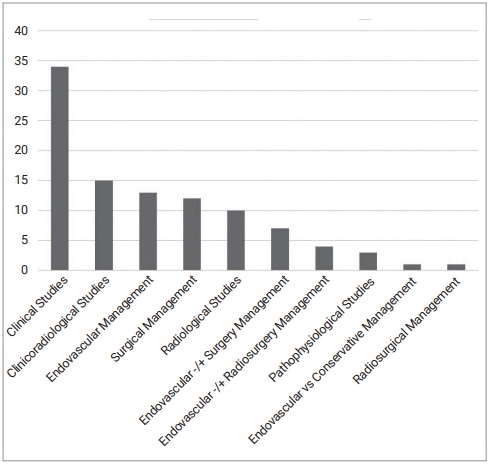
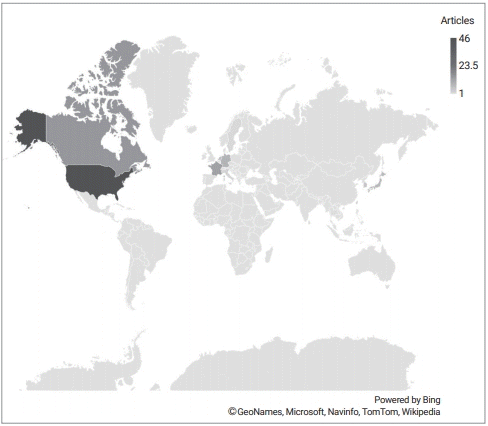




 PDF
PDF Citation
Citation Print
Print



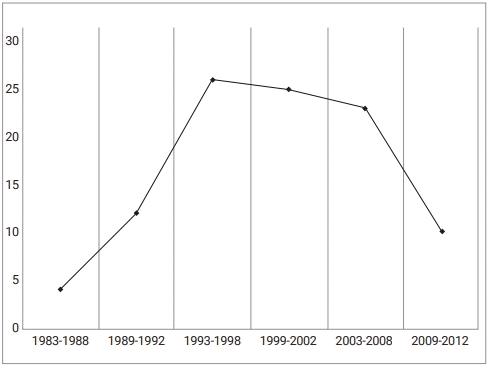
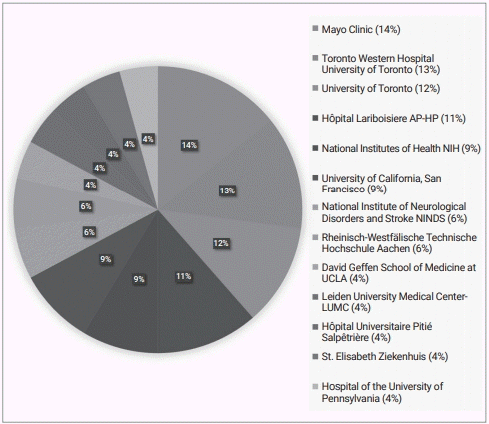
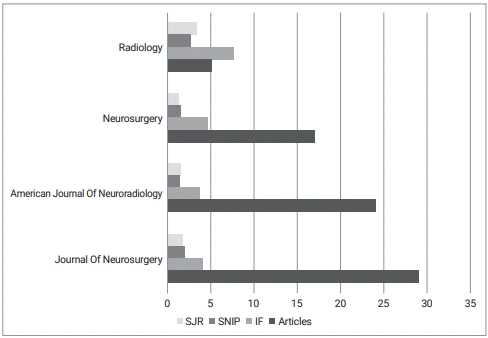
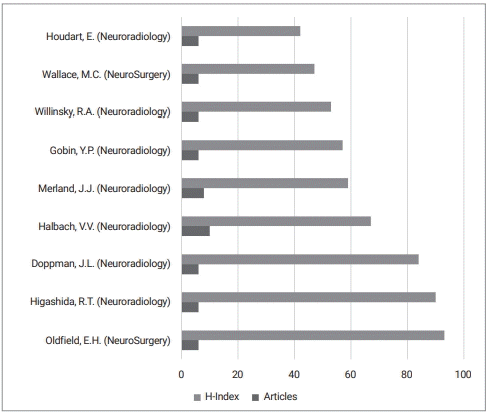
 XML Download
XML Download